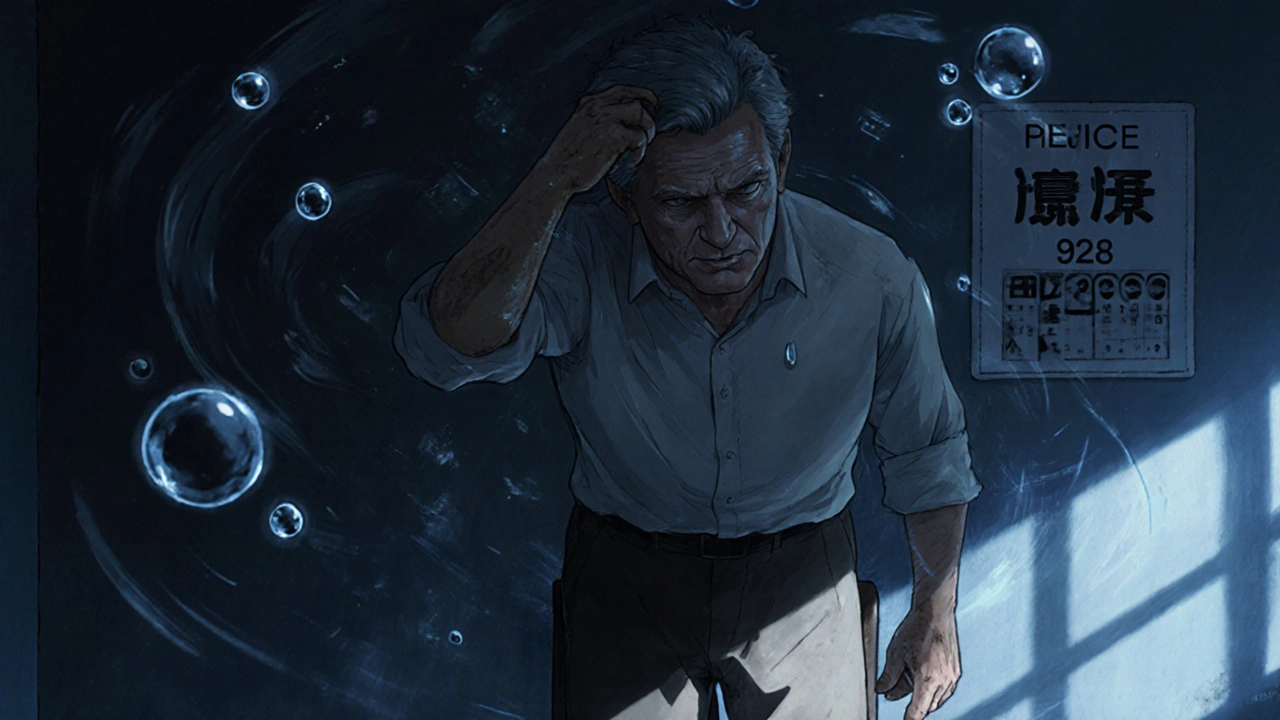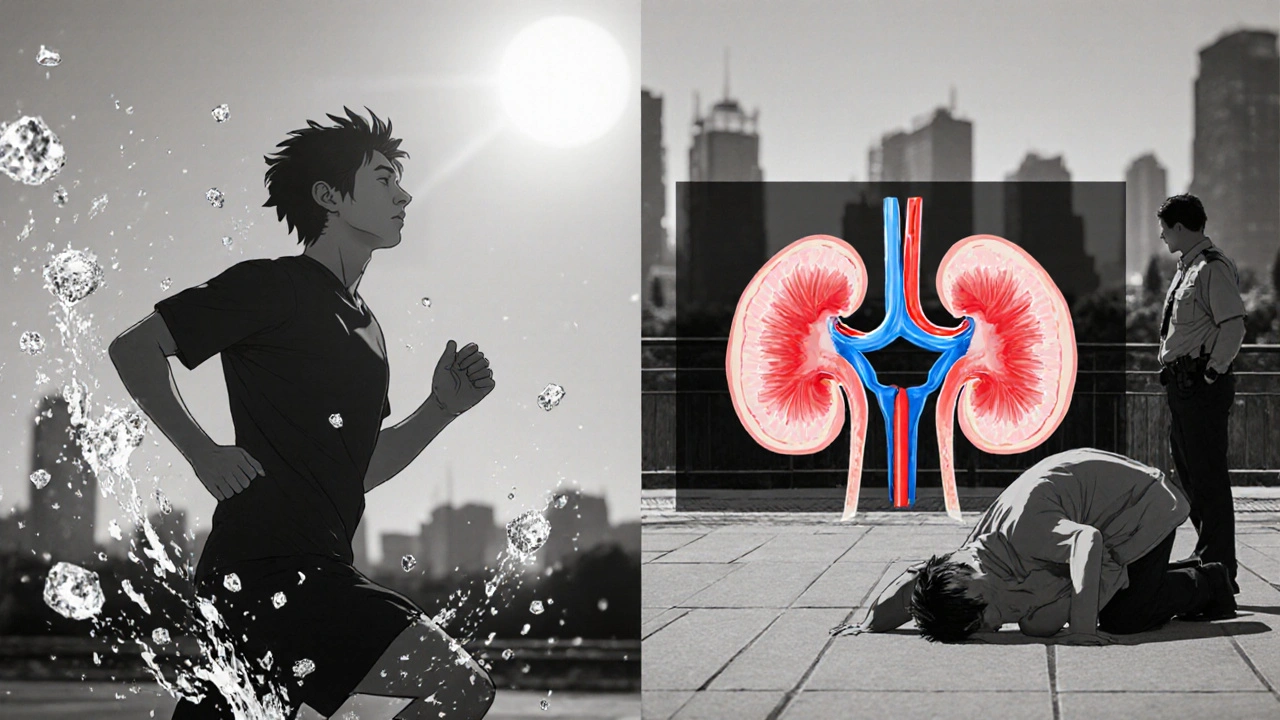SGLT2 Inhibitor Side Effects: Dehydration, Dizziness, and Blood Pressure Changes Explained
 Nov, 16 2025
Nov, 16 2025
SGLT2 Inhibitor Hydration & Blood Pressure Calculator
Calculate Your Fluid Balance
When you start taking an SGLT2 inhibitor like empagliflozin, Farxiga, or Invokana, you’re not just lowering your blood sugar-you’re also changing how your body handles fluid and pressure. These drugs, originally designed for type 2 diabetes, have become go-to treatments for heart failure and kidney disease too. But with those benefits come real side effects: dehydration, dizziness, and drops in blood pressure. If you’re new to these meds or thinking about starting them, you need to know what’s really happening inside your body-and how to stay safe.
How SGLT2 Inhibitors Work Like Natural Diuretics
SGLT2 inhibitors don’t work like insulin or metformin. Instead, they trick your kidneys into spilling glucose into your urine. Normally, your kidneys reabsorb almost all the sugar filtered from your blood. But these drugs block that process, forcing 70-100 grams of glucose out each day. That’s about 250-400 extra calories lost daily-no dieting needed.
Here’s the catch: glucose doesn’t leave alone. It pulls sodium and water with it. That’s why SGLT2 inhibitors act like mild diuretics. You’re not just peeing out sugar-you’re losing 1-1.5 liters of fluid in the first week. That’s the same as skipping a couple of meals and drinking less water. It’s why many people lose 1.5-2.5 kg (3-5 lbs) quickly after starting.
This isn’t a bug-it’s the feature. Less fluid means lower pressure in your blood vessels. That’s why these drugs lower systolic blood pressure by 4-6 mmHg on average. For someone with high blood pressure or heart failure, that’s a win. But for others, especially older adults or those already on blood pressure meds, it can be risky.
Why Dehydration Happens-And Who’s at Risk
Dehydration from SGLT2 inhibitors isn’t rare. Clinical trials show 1.3% to 2.8% of users experience volume depletion symptoms like dry mouth, dark urine, fatigue, or fainting. That’s 2-3 times higher than placebo. In real life, it’s often worse.
Here’s who’s most vulnerable:
- People over 65-thirst signals weaken with age, so you might not notice you’re drying out
- Those on diuretics (like furosemide) or ACE inhibitors-double the fluid loss
- People with eGFR below 60-kidneys can’t compensate as well
- Anyone in hot weather, exercising, or sick with vomiting/diarrhea
A 72-year-old man on Jardiance and lisinopril started feeling lightheaded after a walk in 28°C weather. His blood pressure dropped to 92/58. He didn’t drink extra water because he didn’t feel thirsty. Within days, he was hospitalized for dehydration. This isn’t an outlier-it’s a common story in primary care clinics.
Unlike regular diuretics, SGLT2 inhibitors don’t cause potassium loss. But they do make your body less able to hold onto sodium and water. If you’re not drinking enough, your volume drops fast. And once you’re dehydrated, your kidneys can’t recover without help.
Dizziness: It’s Not Just ‘Feeling Off’-It’s Orthostatic Hypotension
Dizziness is the most reported side effect after dehydration. Around 4-6% of people on SGLT2 inhibitors feel lightheaded, especially when standing up. That’s not normal aging-it’s orthostatic hypotension: your blood pressure plummets when you move from sitting to standing.
Studies show 63% of dizziness cases are tied to this. Your systolic pressure can drop 20 mmHg or more. That’s enough to make you see stars, feel wobbly, or even fall. In one study, patients with baseline systolic pressure under 130 mmHg were nearly three times more likely to get dizzy.
Canagliflozin has the highest dizziness rate-6.3 cases per 1,000 patient-years. Empagliflozin and dapagliflozin are slightly lower. But the timing is the same: 78% of cases happen in the first four weeks. That’s when fluid loss peaks.
Real-world reports on Reddit and Drugs.com confirm this. One user wrote: “Started Jardiance last week. Got dizzy standing up. Thought it was stress. Turned out my BP was 88/54.” Another: “I thought I was just getting old-until my doctor said it was the med.”
The good news? Most cases are mild and fade after 2-4 weeks as your body adjusts. But if you’re dizzy every time you stand, or if it’s affecting your balance, you need to act.

How Blood Pressure Drops-And Why It’s a Double-Edged Sword
SGLT2 inhibitors lower blood pressure in two ways. First, they reduce preload: less fluid in your veins means less pressure pushing back on your heart. Second, they reduce afterload: blood vessels relax because of improved endothelial function and less arterial stiffness.
That’s why these drugs work so well in heart failure. Less pressure on the heart means less strain. In the EMPEROR-Reduced trial, empagliflozin cut heart failure hospitalizations by 30%-even in people without diabetes.
But here’s the flip side: if your blood pressure was already low (below 120 mmHg systolic), this drop can be dangerous. One study found patients with baseline SBP under 120 had a 3.2-fold higher risk of symptomatic hypotension. That’s why doctors now check your blood pressure before prescribing these drugs.
It’s not just about the number. It’s about how you feel. If you’re dizzy, tired, or have blurred vision when standing, your BP might be too low-even if the monitor says 110/70. That’s why orthostatic checks (measuring BP lying and standing) are now standard at the 1-week follow-up.
And here’s something surprising: the blood pressure drop happens whether you have diabetes or not. That’s why these drugs are now approved for heart failure in non-diabetic patients too. The benefit isn’t tied to sugar-it’s tied to fluid and vessel health.
How to Stay Safe: Practical Tips for Patients and Doctors
If you’re on or starting an SGLT2 inhibitor, here’s what you need to do:
- Drink more water. Add 500-1,000 mL (2-4 cups) extra daily, especially in heat or after exercise. Don’t wait until you’re thirsty.
- Check your blood pressure. Take it lying down and then standing. If your systolic drops more than 20 mmHg or you feel dizzy, call your doctor.
- Monitor your weight. A sudden drop of more than 2 kg in a week means you’re losing too much fluid.
- Hold the dose if you’re sick. If you have vomiting, diarrhea, or fever, pause the med until you’re eating and drinking normally.
- Don’t rush the dose. Start with the lowest dose (e.g., empagliflozin 10 mg instead of 25 mg) if you’re older, on other BP meds, or have kidney issues.
- Don’t stop cold turkey. The cardiovascular benefits are strong. If dizziness is mild, your doctor may lower your diuretic dose instead of stopping the SGLT2 drug.
Doctors should screen for these risks before prescribing. Check kidney function, baseline BP, and current meds. Schedule a follow-up at 7-10 days. Most side effects are manageable-if caught early.

When to Worry: Red Flags That Need Immediate Attention
Not all dizziness or dry mouth is harmless. Call your doctor or go to urgent care if you have:
- Confusion or difficulty thinking clearly
- Very dark urine or not peeing for 12+ hours
- Heart palpitations or chest pain
- Systolic BP below 90 mmHg
- Fainting or near-fainting episodes
These aren’t normal side effects-they’re signs of severe volume depletion. Left untreated, they can lead to acute kidney injury or shock. It’s rare, but it happens.
One 78-year-old woman on dapagliflozin and hydrochlorothiazide stopped drinking water because she was “afraid of peeing too much.” She developed kidney failure and had to be hospitalized. She didn’t realize the meds were working too well.
Bottom Line: Benefits Outweigh Risks-If You’re Careful
SGLT2 inhibitors are among the most important diabetes drugs developed in the last decade. They don’t just lower sugar-they protect your heart, kidneys, and blood vessels. In trials, they’ve saved lives. For people with heart failure, one in six avoids death or hospitalization because of them.
But they’re not magic. They’re powerful tools that require smart use. Dehydration, dizziness, and low blood pressure aren’t side effects you ignore. They’re signals. Listen to them. Adjust. Talk to your doctor. Drink water. Check your BP.
If you’re taking one of these meds, you’re not just managing diabetes-you’re managing your body’s fluid balance. That’s a responsibility. But with the right knowledge, it’s a manageable one.
Robert Merril
November 18, 2025 AT 08:47So these drugs make you pee out sugar like a diabetic sprinkler system and wonder why you feel like a dried prune? Classic pharma magic. I started on Jardiance and lost 4 lbs in 3 days. Thought I hit the lottery. Turns out I was just dehydrated and about to pass out in the shower. Doc said drink more water. Yeah thanks captain obvious